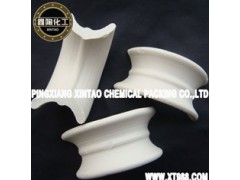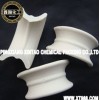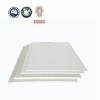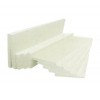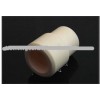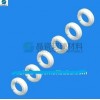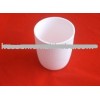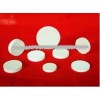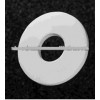Professional Manufacturer Ceramic Intalox Saddles
Diameter:12mm 19mm 25mm 38mm 50m 76mm
ISO9001:2008
Ceramic Intalox Saddles
Ceramic saddle has excellent acid resistance and heat resistance. It can resist to corrosion of various inorganic acids, organic acids and organic solvents except hydrofluoric acid, and can be used in high or low temperature conditions. Consequently the application range is very wide. It can be used in the drying columns, absorbing columns, cooling towers, scrubbing towers and actifier columns in chemical industry, metallurgy industry, coal gas industry, oxygen producing industry, etc.
Chemical composition
|
SiO2 |
Al2O3 |
Fe2O3 |
CaO |
K2O+Na2O |
|
>70% |
23-30% |
<1% |
<1-2% |
<2-4% |
Physical properties
|
Index |
Value |
|
Specific gravity(g/cm3) |
2.25-2.35 |
|
Water absorption(%) |
<0.5 |
|
Acid-resisting strength, %Wt. Loss (ASTMc279) |
<4 |
|
Firing temperature() |
1280-1320 |
|
Softening point() |
>1400 |
|
Density(kg/m3) |
2350 |
Technical data
|
Spec. (inch) |
Spec. (mm) |
Approx. weight (kg/m3) |
Surface area (m²/m³) |
Free volume (%) |
Packing factor (l/ft) |
|
1/2 |
12 |
720 |
623 |
71.7 |
200 |
|
3/4 |
19 |
688 |
334 |
73 |
130 |
|
1 |
25 |
688 |
253 |
73 |
85 |
|
1.5 |
38 |
640 |
164 |
75 |
50 |
|
2 |
50 |
577 |
115 |
77.4 |
37 |
|
3 |
76 |
623 |
92 |
75.5 |
24 |
Advantages
These saddles are made from chemical porcelain and have excellent resistance to acids except in the case of hydrofluoric acid.
Moisture absorption must less than half a percent.
The porcelains specific gravity is 2.3-2.4g/cm3 and an average heat capacity (between 20 and 500 of 0.22 cal/g.)
XINTAO ceramic saddles softening point is 1400 min. And they show good thermal shock resistance during repeated cycling between 20 and 820 .
Thermal shock test for Intalox Saddles
For example shipping the saddles over 80 M3:
1) Randomly pick 100-200 pieces of ceramic saddles for RTOs from the batch or shipment
2) For each sample selected, heat it up to 820 and maintain them at this temperature for 30 minutes.
3) Drop the hot pieces into cold 20 water
4) Repeat steps 2 & 3 for10 times on each and every piece in the sample lot.
5) Examine the pieces and count the percent that show clear signs of breakage and/or cracking. Our standard is less than seven (7%) percent.



